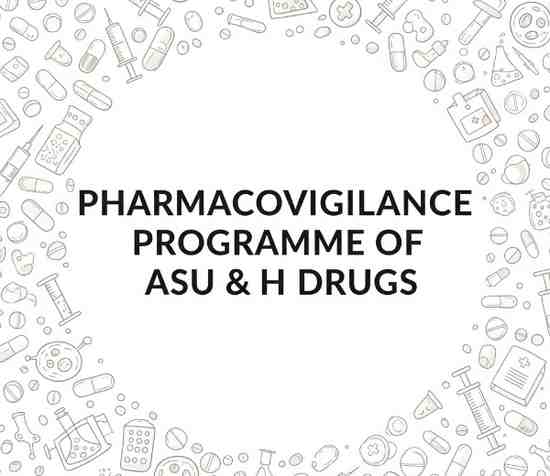
Your Account
Designed by Zeptt Technologies

Pharmacovigilance refers to the science and activities related to the detection, assessment, understanding, and prevention of adverse effects or any other drug-related problems.
For traditional medicine systems like Ayurveda, Siddha, Unani, and Homeopathy, pharmacovigilance plays a vital role in ensuring the safety and efficacy of classical and proprietary formulations.
The Department of AYUSH launched the Pharmacovigilance Programme for ASU&H Drugs to strengthen patient safety and promote rational use of medicines in traditional systems.
SANSKRIT REFERENCE ON DRUG SAFETY
"न हि सर्वेषु कालेषु सर्वं सर्वत्र साधनम्।
स्वभावतो वा दोषेण कार्याण्यन्यथास्युरपि॥"
— Charaka Samhita, Sutrasthana 30/26
(Translation: Not all treatments are suitable at all times and places; due to inherent nature or defects, the intended action may sometimes fail.)
NEED FOR PHARMACOVIGILANCE IN ASU & H DRUGS
Increased usage of traditional medicines globally.
Self-medication practices are common.
Adulteration, substitution, and contamination of drugs.
Irrational combinations in proprietary formulations.
Reported cases of drug-induced toxicity (e.g., heavy metal toxicity).
Drug interactions with modern medicine in integrative treatment.
OBJECTIVES OF THE PROGRAMME
To develop a systematic reporting system for adverse drug reactions (ADRs) of ASU&H drugs.
To document and analyze data to ensure drug safety.
To educate and create awareness among stakeholders (physicians, pharmacists, manufacturers, and patients).
To recommend regulatory decisions based on ADR data.
To promote rational use of ASU&H medicines.
STRUCTURE OF THE PHARMACOVIGILANCE PROGRAMME
Launched by: Ministry of AYUSH, Government of India in 2008.
National Coordinating Centre (NCC): All India Institute of Ayurveda (AIIA), New Delhi.
Peripheral Pharmacovigilance Centres (PPvCs): Located in colleges, hospitals, and research institutions.
Intermediary Pharmacovigilance Centres (IPvCs): Monitor and analyze data received from PPvCs.
Data is uploaded to the central portal: www.ayushsuraksha.com
CATEGORIES OF PHARMACOVIGILANCE ACTIVITIES
Adverse Drug Reaction Monitoring
Spontaneous reporting of suspected ADRs.
Causality assessment using WHO-UMC scale.
Documentation of Classical Toxicity
Based on textual references (e.g., visha dravya, uparasa, nishiddha yogas).
Monitoring Misbranded, Adulterated, Spurious Drugs
Enforcement under Drugs & Cosmetics Act 1940, Rule 158(B).
Case documentation of heavy metal toxicity and adverse events associated with Rasa aushadhis.
Public awareness programmes and training of stakeholders.
MODERN CONCEPTS AND TOXICOLOGY IN RASASHASTRA
Heavy metals like Mercury (Parada), Arsenic (Haratala), Lead (Naga), etc., though processed (Shodhana & Marana), can cause toxicity if improperly handled.
Studies show biotransformation and detoxification reduce toxicity post-Shodhana.
Emphasis on analytical quality control using ICP-MS, AAS, HPLC, TLC, GC-MS.
Good Manufacturing Practices (GMP) and Shelf-life standards are mandated.
Monitoring herb-drug interactions in co-administered therapies.
KEY GUIDELINES AND REGULATIONS
Drugs and Cosmetics Act, 1940 & Rules 1945: Rule 158(B) – Essential requirements for safety & efficacy of ASU drugs.
Schedule T: GMP requirements for Ayurvedic drugs.
Pharmacopoeial standards from API (Ayurvedic Pharmacopoeia of India) and UNANI Pharmacopoeia.
Reporting tools: AYUSH Adverse Drug Reaction reporting form available on AYUSHSuraksha portal.
ROLE OF PHYSICIANS AND STUDENTS
Encourage ADR reporting even if unsure of causality.
Maintain patient records with clear documentation of ASU drug history.
Understand indications, contraindications, drug interactions from classical and modern perspectives.
Utilize classical references for rational formulation use and avoid pravritta yogas with known toxic potential.
"युक्तियोगं हि भैषज्यमग्निदोषानुसारतः।
नात्यर्थमोषधं कुर्यान्न ही स्याच्छान्तिकारणम्॥"
— Ashtanga Hridaya, Sutrasthana 1/14
(Translation: The medicines should be used judiciously in appropriate combinations according to the doshas and agni, excessive use is not beneficial.)
CHALLENGES IN IMPLEMENTATION
Lack of awareness among practitioners and patients.
Incomplete ADR reporting due to fear or ignorance.
Inadequate analytical facilities in many institutions.
Poor documentation and record-keeping practices.
Traditional belief that Ayurveda drugs are always safe delays reporting.
STRATEGIES TO STRENGTHEN PHARMACOVIGILANCE IN ASU&H
Inclusion of Pharmacovigilance training in BAMS curriculum.
Regular CME programs, workshops, and awareness campaigns.
Strong collaboration between regulators, academia, industry, and physicians.
Use of mobile apps and digital portals for easy ADR reporting.
Development of digital pharmacovigilance databases and research integration.